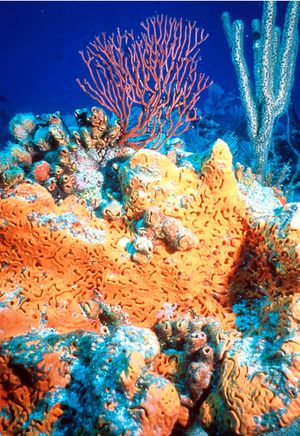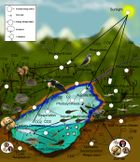التكيف اللوني


التكيف اللوني Homochromy أو Animal coloration هو قدرة بعض الحيوانات على مطابقة ألوانها مع ألوان الوسط المحيط بها، إما بتفضيلها المعيشة على مرتكز له اللون ذاته (تجانس لوني بسيط أو سلبي)، وإما بتغيير لونها بتأثير الأشعة الضوئية في أصبغتها الجلدية (تجانس لوني متبدل أو مُحَرَّض)، وإما بابتلاع مواد غذائية ملونة تنتشر في جسمها (تجانس لوني غذائي). وهو أحد الوسائل الفعالة في حماية الحيوان، شريطة أن يبقى ثابتاً غير متحرك.
. . . . . . . . . . . . . . . . . . . . . . . . . . . . . . . . . . . . . . . . . . . . . . . . . . . . . . . . . . . . . . . . . . . . . . . . . . . . . . . . . . . . . . . . . . . . . . . . . . . . . . . . . . . . . . . . . . . . . . . . . . . . . . . . . . . . . . . . . . . . . . . . . . . . . . . . . . . . . . . . . . . . . . . .
التاريخ

Animal coloration has been a topic of interest and research in biology for centuries.
In his 1665 book Micrographia, Robert Hooke describes the "fantastical" (structural, not pigment) colours of the Peacock's feathers:[1]

the effect of a disruptive pattern is to break up what is really a continuous surface into what appears to be a number of discontinuous surfaces... which contradict the shape of the body on which they are superimposed.
— Hugh Cott[2]
Evolutionary reasons for animal coloration
Camouflage
التكيف اللوني البسيط
التكيف مع الأعشاب والنباتات
يتلون كثير من الحشرات باللون الأخضر، فكثير من يرقات الفراشات التي تعيش على الأوراق، تكون خضراً وصعبة الرؤية. ويلاحظ الشيء نفسه لدى العديد من أنواع الجراد والبق وغمديات الأجنحة والعناكب والفقاريات. ومن بين الزواحف هناك السحالي والحرابي.
أما الأفاعي فيرتبط تجانسها اللوني غالباً بتماثل الشكل، فيكون شكلها نحيلاً ومتطاولاً مما يجعلها شديدة الشبه بسوق النباتات أو النباتات المتسلقة الخضراء. أما الضفادع فالمثال المشهور هو ضفدع الشجر. كما تبدي الطيور أنماطاً عدة من التكيف اللوني، وخاصة ببغاء الأمازون ودجاجة الأرض التي يصعب رؤيتها بسبب امتزاج ريشها مع النباتات المحيطة بها.
التكيف اللوني مع التربة
تصعب رؤية أرنب كامن في قعر ثلم في أرض محروثة، حيث يمتزج لونه مع لون الأرض. والشيء نفسه لدى بعض القوارض كالجرذ الجرابي وفأر القنغر اللذين يقترب لونهما من لون الأرض التي يتمركزان عليها. كما تبدي بعض الطيور تكيفاً لونياً فعالاً، فالصيادون يعلمون مدى الصعوبة في العثور على حجل مجروح في الحقل. والأغرب من ذلك هو السلوك الذي تبديه الطيور عند وضع البيض. فإذا كان العش مخفياً، فإن البيوض تكون عادة بيضاء اللون، فلا داعي لتمويهها. أما إذا كان العش سيء التمويه فإن البيوض تكون إما ملونة بكاملها بلون بقايا النباتات المجاورة (دجاجة الأرض) وإما مزينة ببقع تخفي شكلها (الزقزاق).
التكيف اللوني مع الصحراء
يكون لون الأرض في المناطق الصحراوية مرئياً جداً بسبب ندرة النباتات فيها. وفي هذه الحالة تتلون الحيوانات الصحراوية بالأصفر الفاقع بلون الرمال. وتبدي الحشرات الصحراوية حالتين مختلفتين جداً: بعضها يأخذ لون الرمال أو الحصى، وبعضها الآخر يأخذ اللون الأسود ولا يبدي أي ميل للتكيف اللوني.
التكيف اللوني مع الثلوج
تقدم الحيوانات التي تعيش على الثلج أيضاً مثالاً آخر عن التجانس اللوني. فالثعالب البيض والدببة القطبية تكتسي أجسامها في فصل الشتاء بفرو أبيض ناصع مع بعض البقع السود، وكذلك الطيور كحجل الثلج. وتحتفظ بعض الحيوانات بلونها الأبيض على مدار العام كالدب القطبي وبوم الثلج، ويأخذ بعضها الآخر لوناً غامقاً في فصل الصيف كثعلب القطب وحجل الثلج (تكيف لوني فصلي).
التكيف اللوني مع قاع المياه
تأخذ الأسماك التي تتمدد على القاع لوناً يقارب كثيراً لون ذلك القاع. وبصورة عامة تكون الأسماك التي تعيش في مستنقعات قاعها طيني أكثر قتامة من تلك التي تعيش في مياه صافية, ويلاحظ الشيء ذاته في البحار، حيث يبدي عدد من الأسماك لوناً يتبدل بحسب لون القاع. وتذكر هنا أسماك الأرصفة المرجانية وأسماك القرش الصغيرة. أما الأسماك المسطحة فتبدي مقدرة كبيرة على التكيف مع لون القاع ليس فقط لأن لونها يمكن أن يتدرج من الأبيض إلى الرمادي الفاتح، بل لأنه يمكنها أيضاً إظهار درجات لونية مختلفة من الأخضر والأصفر والبرتقالي والوردي.
التكيف اللوني المتبدل
يدعى أيضاً بالتكيف اللوني المُحَرَّض، ويقتصر على الحيوانات التي تمتلك خلايا صباغية خاصة تدعى حاملات الصبغة، كالفقاريات الدنيا والرخويات رأسيات الأرجل Cephalopoda والقشريات Crustacea، إذ يتبدل لون الأنواع التي لها قشيرة شفافة، في هذه المجموعة الأخيرة، نوعاً ما، مثل مختلفات الأرجل Amphipoda ومتماثلات الأرجل Isopoda وعشاريات الأرجل Decapoda. والمثال المعروف هو الجمبري (القريدس) الصغير الذي يعيش في شواطئ الأطلسي ويدعوه الإنكليز الجمبري الحرباء بسبب قدرته الفائقة على التكيف مع ألوان الطحالب التي يعيش عليها. ويبدو أن آلية التكيف الصباغي لدى القشريات تخضع تماماً لسيطرة هرمون يحدد انتقال الحبيبات الصباغية في الاستطالات المتشعبة للخلايا حاملة الصبغة.
وتقدم الرخويات رأسيات الأرجل أمثلة بارزة عن التلون المتغير، سواء بتأثير منبهات مختلفة المنشأ أو باستجابة للون الوسط. فالحبار أو الأخطبوط يتلون بلون القاع الذي يعيش عليه. ولكن ما يثير الدهشة هو تغير اللون بسبب الانفعالات كالخوف والغضب.
أما الضفادع فتلاحظ تبدلاتها اللونية السريعة لدى عديمات الذنب، وخاصة ضفادع الشجر، إذ تخضع هذه التبدلات لديها لتأثير عدة عوامل خارجية كالحرارة والضوء والاضطرابات التنفسية، إضافة إلى المنبهات اللمسية والبصرية. أما لدى الزواحف فيتبدل لون العظائيات بسرعة، ومثال ذلك الحرادين والإغوانات والحرابي المشهورة بالتكيف اللوني المحرض. ويعود تبدل لون الزواحف إلى سرعة انتقال الصباغات في خلاياها الصباغية، وذلك كرد فعل على المنبهات الخارجية.
التكيف اللوني الغذائي
لوحظ أن بعض الرخويات اللاحمة من مجموعة عاريات الغلاصم Nudibranchia التي تعيش على الإسفنجيات أو الكأسيات زاهية الألوان والتي تتغذى بها، يكون لها ألوان غذائها، لا في اللحافات فقط، بل في الكتلة الحشوية أيضاً.
ولابد من ذكر أن كثيراً من الحيوانات السابحة تكون شفافة تماماً، أو ذات لون أزرق خفيف. ولهذا السبب يتعذر رؤيتها في ماء البحر. وتنطبق هذه الحالة على كل اليرقات والقشريات الصغيرة التي تؤلف العوالق وعلى عدد كبير من الكائنات البحرية الكبيرة كالميدوسات والأنبوبيات وحاملات الأمشاط.
التلون كرسالة
Colour is widely used for signalling in animals as diverse as birds and shrimps. Signalling encompasses at least three purposes:
- advertising, to signal a capability or service to other animals, whether within a species or not
- sexual selection, where members of one sex choose to mate with suitably coloured members of the other sex, thus driving the development of such colours
- warning, to signal that an animal is harmful, for example can sting, is poisonous or is bitter-tasting. Warning signals may be mimicked truthfully or untruthfully.
. . . . . . . . . . . . . . . . . . . . . . . . . . . . . . . . . . . . . . . . . . . . . . . . . . . . . . . . . . . . . . . . . . . . . . . . . . . . . . . . . . . . . . . . . . . . . . . . . . . . . . . . . . . . . . . . . . . . . . . . . . . . . . . . . . . . . . . . . . . . . . . . . . . . . . . . . . . . . . . . . . . . . . . .
الإعلان
Sexual selection

Darwin observed that the males of some species, such as birds of paradise, were very different from the females.
Mimicry
Distraction
Startle
Motion dazzle
Physical protection
Temperature regulation
Incidental coloration

Mechanisms of colour production in animals

Coloration by pigments

Variable coloration by chromatophores
Chromatophores are special pigment-containing cells that can change their size, thus varying the colour and pattern of the animal. The voluntary control of chromatophores is known as metachrosis.[3] For example, cuttlefish and chameleons can rapidly change their appearance, both for camouflage and for signalling, as Aristotle first noted over 2000 years ago:[4]
The octopus ... seeks its prey by so changing its colour as to render it like the colour of the stones adjacent to it; it does so also when alarmed.
— Aristotle

. . . . . . . . . . . . . . . . . . . . . . . . . . . . . . . . . . . . . . . . . . . . . . . . . . . . . . . . . . . . . . . . . . . . . . . . . . . . . . . . . . . . . . . . . . . . . . . . . . . . . . . . . . . . . . . . . . . . . . . . . . . . . . . . . . . . . . . . . . . . . . . . . . . . . . . . . . . . . . . . . . . . . . . .
Structural coloration

| Mechanism | Structure | Example |
|---|---|---|
| Diffraction grating | layers of chitin and air | Iridescent colours of Butterfly wing scales, Peacock feathers[5] |
| Diffraction grating | tree-shaped arrays of chitin | Morpho butterfly wing scales[5] |
| Selective mirrors | micron-sized dimples lined with chitin layers | Papilio palinurus, emerald swallowtail butterfly wing scales[5] |
| Photonic crystals | arrays of nano-sized holes | Cattleheart butterfly wing scales[5] |
| Crystal fibres | hexagonal arrays of hollow nanofibres | Aphrodita, sea mouse spines[5] |
| Deformed matrices | random nanochannels in spongelike keratin | Diffuse non-iridescent blue of Ara ararauna, blue-and-yellow macaw[5] |
| Reversible proteins | reflectin proteins controlled by electric charge | Iridophore cells in Loligo pealeii squid skin[5] |
Bioluminescence
Bioluminescence is the production of light, such as by the photophores of marine animals,[6] and the tails of glow-worms and fireflies. Bioluminescence, like other forms of metabolism, releases energy derived from the chemical energy of food. A pigment, luciferin is catalysed by the enzyme luciferase to react with oxygen, releasing light.[7] Comb jellies such as Euplokamis are bioluminescent, creating blue and green light, especially when stressed; when disturbed, they secrete an ink which luminesces in the same colours. Since comb jellies are not very sensitive to light, their bioluminescence is unlikely to be used to signal to other members of the same species (e.g. to attract mates or repel rivals); more likely, the light helps to distract predators or parasites.[8] Some species of squid have light-producing organs (photophores) scattered all over their undersides that create a sparkling glow. This provides counter-illumination camouflage, preventing the animal from appearing as a dark shape when seen from below.[9] Some angler fish of the deep sea, where it is too dark to hunt by sight, contain symbiotic bacteria in the 'bait' on their 'fishing rods'. These emit light to attract prey.[10]
انظر أيضاً
الهامش
- ^ Hooke, R. Micrographia. Chapter 36 ('Observ. XXXVI. Of Peacoks, Ducks, and Other Feathers of Changeable Colours.').
- ^ Cott, 1940. p51
- ^ خطأ استشهاد: وسم
<ref>غير صحيح؛ لا نص تم توفيره للمراجع المسماةWallin - ^ Aristotle. Historia Animalium. IX, 622a: 2-10. About 400 BC. Cited in Luciana Borrelli, Francesca Gherardi, Graziano Fiorito. A catalogue of body patterning in Cephalopoda. Firenze University Press, 2006. Abstract Google books
- ^ أ ب ت ث ج ح خ خطأ استشهاد: وسم
<ref>غير صحيح؛ لا نص تم توفيره للمراجع المسماةBall - ^ Shimomura, Osamu (2012) [2006]. Bioluminescence: chemical principles and methods. World Scientific.
- ^ Kirkwood, Scott (Spring 2005). "Park Mysteries: Deep Blue". National Parks Magazine. National Parks Conservation Association. pp. 20–21. ISSN 0276-8186. Retrieved 26 November 2011.
- ^ Haddock, S.H.D., and Case, J.F. (April 1999). "Bioluminescence spectra of shallow and deep-sea gelatinous zooplankton: ctenophores, medusae and siphonophores" (PDF). Marine Biology. 133: 571–582. doi:10.1007/s002270050497. Retrieved 25 November 2011.
{{cite journal}}: CS1 maint: multiple names: authors list (link) - ^ "Midwater Squid, Abralia veranyi". Midwater Squid, Abralia veranyi (with photograph). Smithsonian National Museum of Natural History. Retrieved 7 February 2012.
- ^ Piper, Ross. Extraordinary Animals: An Encyclopedia of Curious and Unusual Animals. Greenwood Press, 2007.
المصادر
- محمد النعمة. "التكيف اللوني". الموسوعة العربية.











